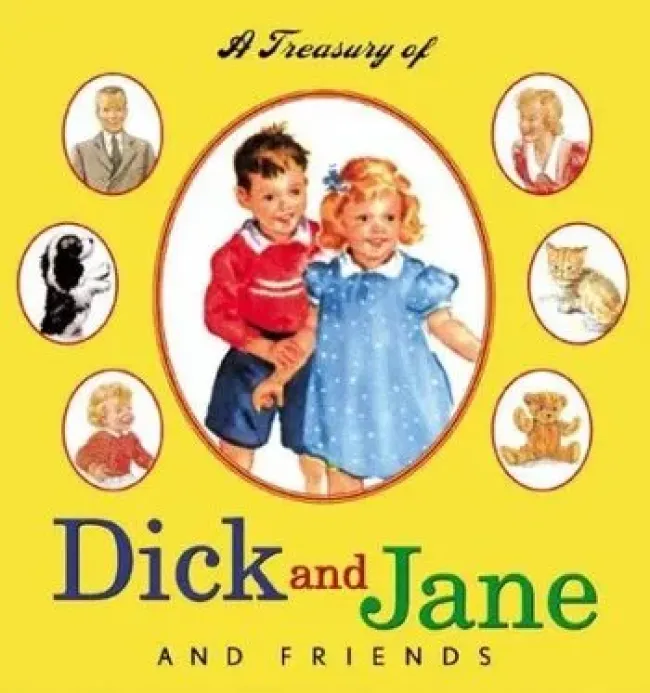The Dick and Jane Series: Nostalgia or Cultural Blind Spot?
First introduced in the 1930s, the Dick and Jane series is more than just a set of children’s primers—it’s a cultural touchstone that shaped literacy for generations. Yet, beneath its cheerful watercolors and simple phrases lies a contentious legacy: a sanitized portrayal of white, middle-class America that excluded diversity and upheld rigid societal norms. Was it an educational breakthrough or a reflection of the era’s narrow worldview?
The Rise of Dick and Jane: A Literacy Revolution
When educator Zerna Sharp and author William S. Gray launched Dick and Jane, they upended traditional phonics-based instruction. Instead of sounding out words, children memorized them through repetition, aided by iconic lines like “See Spot run. Run, Spot, run!” By the 1950s, an estimated 80% of American first-graders were learning to read using these books—a testament to their dominance in classrooms.
The series centered on a picture-perfect nuclear family: Dick, the adventurous older brother; Jane, the helpful sister; Sally, the cheerful toddler; and their nameless parents, “Mother” and “Father.” Their idyllic world of suburban lawns, playful adventures, and wholesome chores became synonymous with mid-century American childhood. For many Baby Boomers, these books evoke nostalgia for a seemingly simpler time.
The Hidden Curriculum: Reinforcing the Status Quo
While Dick and Jane taught millions to read, it also perpetuated a narrow, exclusionary vision of American life.
- Gender Roles: Jane was consistently depicted in passive, domestic roles, assisting her mother, while Dick embodied active, adventurous masculinity, mirroring his father. This reinforced 1950s ideals of gendered behavior.
- Racial Exclusivity: Until 1965, the Dick and Jane universe was almost entirely white. When an African American family—Mike, Pam, and Penny—was finally introduced, their stories were separate from the main characters, mirroring but not integrating with the original family. This token inclusion failed to challenge systemic racial segregation.
- Class Privilege: The series idealized suburban affluence, alienating children from working-class or marginalized backgrounds. As Toni Morrison explored in The Bluest Eye, the glorification of “perfect” white families perpetuated harmful beauty standards and reinforced social inequalities.
The Fall of Dick and Jane
By the 1970s, Dick and Jane had lost its dominance. Critics attacked its reliance on the “look-say” method, arguing that it neglected essential phonics skills. At the same time, shifting cultural values called for stories that better reflected the diversity of American society. Dr. Seuss’s The Cat in the Hat (1957) and later series like Junie B. Jones introduced humor, imagination, and relatable characters, making Dick and Jane feel outdated.
Despite its decline, the series has remained culturally significant. Reprints in the 2000s, fueled by Baby Boomer nostalgia, sold millions of copies. Vintage editions became collector’s items, and parodies like Feminist Fairy Tales offered modern critiques of the series’ outdated norms.
Lessons for Today’s Education
The legacy of Dick and Jane offers important insights for modern education:
- Representation Matters: The exclusionary lens of Dick and Jane serves as a cautionary tale. Contemporary children’s books, such as Hair Love and Last Stop on Market Street, strive to celebrate diversity and inclusivity.
- Effective Teaching Methods: The shortcomings of the “look-say” method highlight the importance of evidence-based approaches like phonics, which remain central to literacy education today.
- Balancing Nostalgia with Progress: While the series’ simplicity and charm evoke fond memories, it’s crucial to recognize its limitations and prioritize stories that reflect the realities and aspirations of all children.
Conclusion: A Legacy of Lessons
The Dick and Jane series is both a cultural artifact and a mirror of its time. While it played a significant role in literacy education, it also reinforced exclusionary ideals and societal biases. Today, as we strive for stories that uplift and empower all children, Dick and Jane reminds us of the importance of learning from the past while building a more inclusive future.
“Look, look. Dick and Jane are back.” But this time, we envision a world where every child sees themselves in the pages.
